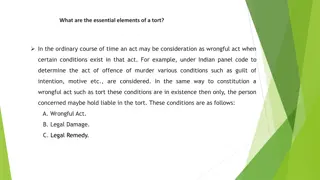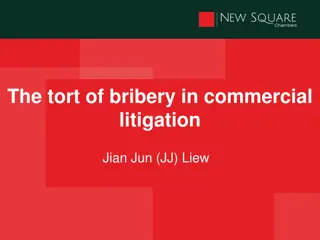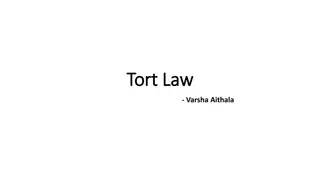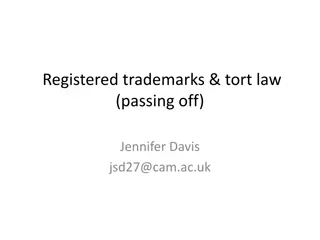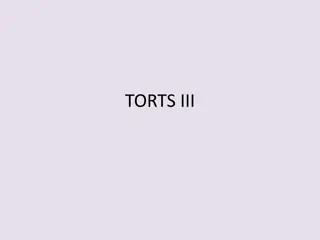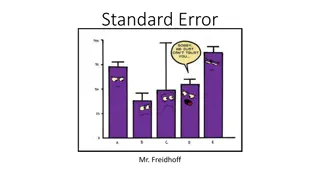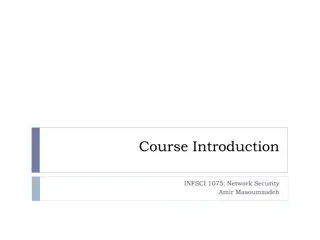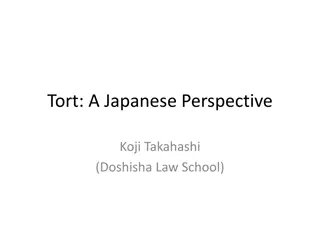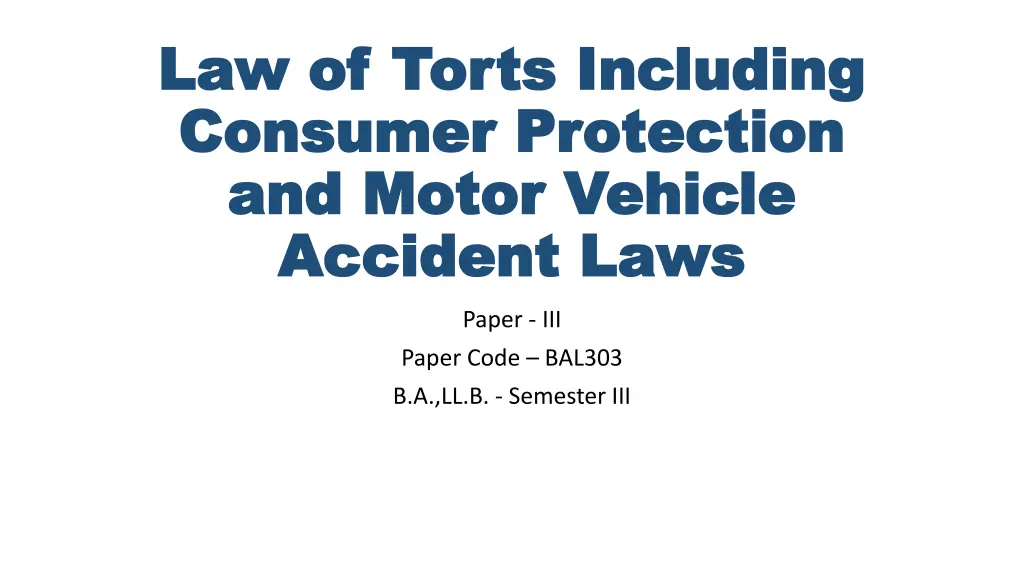
Understanding the Law of Torts and Consumer Protection in Legal Studies
Explore the fundamental concepts of the law of torts, including definitions, nature, scope, and objects. Learn about tortfeasors, civil wrongs, and the remedy of unliquidated damages. Delve into the Indian Limitation Act of 1963 and renowned legal definitions by Salmond and Winfield. Enhance your knowledge of tort law with insights from Sir Frederick Pollock.
Download Presentation

Please find below an Image/Link to download the presentation.
The content on the website is provided AS IS for your information and personal use only. It may not be sold, licensed, or shared on other websites without obtaining consent from the author. If you encounter any issues during the download, it is possible that the publisher has removed the file from their server.
You are allowed to download the files provided on this website for personal or commercial use, subject to the condition that they are used lawfully. All files are the property of their respective owners.
The content on the website is provided AS IS for your information and personal use only. It may not be sold, licensed, or shared on other websites without obtaining consent from the author.
E N D
Presentation Transcript
Law of Torts Including Law of Torts Including Consumer Protection Consumer Protection and Motor Vehicle and Motor Vehicle Accident Laws Accident Laws Paper - III Paper Code BAL303 B.A.,LL.B. - Semester III
Unit - 1 Introduction Definition Nature Scope Objects Elements of Tort Maxims Extinction or discharge of tortious Liabilty Joint Tort-feasors
Definition,Nature,Scope and Objects Definition,Nature,Scope and Objects Word Tort has been derived from Latin term tortum which means to twist . In general sense tort means wrong . Law of Tort is based upon the English Law. It is a uncodified law. Tort basically means any wrongful act which causes injury to any person. This branch of law consists of various torts or wrongful act whereby the wrongdoer violates some legal right vested in another person.
Tort is a private wrong. It is a right in rem i.e right against the whole world at large. Right in personam Unliquidated damages are provided.
Meaning of tort The person committing tort or wrong is called a tort-feasor or wrong doer, and his misdoing is a tortious act. The principal aim of the law of torts is compensation of victims or their dependants. Grant of exemplary damages in certain cases will show that deterrence of wrong-doers is also another aim of the law of torts.
Definition Salmond definition - A tort is a civil wrong for which the remedy is a common law action for unliquidated damages, and which is not exclusively the breach of contract or the breach of trust or other merely equitable obligation. Winfield definition Tortious liability arises from the breach of a duty primarily fixed by law, this duty is towards persons generally and its breach is redressable by an action for unliquidated damages.
Indian Limitation Act, 1963 Section 2(M) defines Tort is a civil wrong which is not exclusively breach of contract or breach of trust. Frazer Tort is a violation of a legal right which justifies the aggrieved party to bring in an action for damages against the wrongdoer
Sir Frederick Pollock- Every tort is an act or omission (not being merely the breach of a duty arising out of a personal relation, or undertaken by contract) which is related in one of the following ways to harm (including reference with an absolute right, whether there be measurable actual damage or not), suffered by a determinate person:- a) It may be an act which, without lawful justification or excuse, is intended by the agent to cause harm, and does cause the harm complained of. b) It may be an act in itself contrary to law, or an omission of specific legal duty, which causes harm not intended by the person so acting or omitting. c) It may be an act violation the absolute right (especially rights of possession or property), and treated as wrongful without regard to the actor s intention or knowledge. This, as we have seen is an artificial extension of the general conceptions which are common to English and Roman law. d) It may be an act or omission causing harm which the person so acting or omitting to act did not intend to cause, but might and should with due diligence have foreseen and prevented. e) It may, in special cases, consist merely in not avoiding or preventing harm which the party was bound absolutely or within limits, to avoid or prevent.
ubi ubi jus jus ibi ibi remedium remedium Where there is a legal right there is a legal remedy. There is no wrong without remedy. The law of tort is concerned with the conservation of right in rem.
Law of Tort Salmond called it as law of torts whereas Winfiled termed it as law of Tort. Salmond did not believe in the principle of ubi jus ibi remedium. He formulated a Pigeon Hole Theory. Salmond calls it law of torts. He argued in his pigeon hole theory that there is no general principle of liability (ubi jus ibi remedium) & if the Plaintiff can place his wrong under any one of the nominated or labelled torts he can succeed and not otherwise. This means as per Salmond category of torts has closed & no wrong other than those already nominated can be treated as torts. He also argued that just as Criminal Law consist of body of rules establishing specific offences, so also the law of torts consist of body of rules establishing specific injuries. Tort (Winfield)or Law of Torts (Salmond) Torts (Salmond)
On the other hand Winfield holds that it is LAW OF TORT because every wrongful act for which there is no justification or excuse is to be treated as tort. According to him, the category of tort never closes and there is always a scope for new tort being included in this branch of law if it fits in the principle. This theory has been supported by Holt, CJ in Ashby v. White wherein he observed, if a man will multiply injuries, action must be multiplied too, for every man who is injured ought to have compensate.
Pratt J, in Champan v. Pickergill held that Tort are infinite, various not limited or confined.
Characteristics of Tort It is a civil wrong It arise from breach of duty It is different from the breach of contract and breach of trust It is different than a criminal wrong It is remedied by unliquidated damages.
Objects of Law of Torts Tort law is Based on the Idea that everyone in our society has certain rights. Along with having certain rights, everyone has the duty to respect the rights of the others. The purpose of Tort law is to enforce those rights and duties. Award compensation Shifting of loss to person who caused it or to the beneficiary To protect the interests and rights of a person like, property, person and reputation To provide appropriate remedy for violation of rights
Development of Law of Torts in India Development of Law of Torts in India The law of torts in India is based on the English Law of Torts. It is made applicable in India as per the circumstances. Development of Law of Torts in India is very slow because 1. The Law of Torts is uncodified law. 2. Apathy of Legal System 3. Lack of right consciousness 4. Habit of tolerance. 5. Delayed Judicial proceeding 6. Inability of the wrongdoer to pay damages
Elements of Law of Torts Elements of Law of Torts The law of torts is fashioned as an instrument for making people adhere to the standards of reasonable behavior and respect the rights and interests of one another. This it does by protecting interests and by providing for situations when a person whose protected interest is violated can recover compensation for the loss suffered by him from the person who has violated the same.
To constitute a tort There must be a wrongful act committed by a person; The wrongful act must be of such a nature as to give rise to a legal remedy and Such legal remedy must be in the form of an action for unliquidated damages.
Wrongful ACT Wrongful ACT An act which prima facie looks innocent may becomes tortious, if it invades the legal right of another person. The act complained must be legally wrongful act. A legal right is created by law and is enforceable. Legal rights are numerous and it is still growing Wrongful act include- act or omission.
TEST FOR WRONGFUL ACT TEST FOR WRONGFUL ACT The test for the wrongful act is to check the prejudice effect on the legal right of another. The Burden of Proof of which lies on the plaintiff. From the point of view of presumption of damage, rights are classified into 1. Absolute right It is actionable per se. When these rights are violated, Law conclusively presumes damages without any actual pecuniary loss. Only violation of legal right has to be proved. (Ashby v White) 2. Qualified right Here plaintiff has to prove violation of legal right as well as the injury caused. There is no presumption as to legal damage. It is actionable only on proof of damage.
Legal injury or legal damage It means injury in the eye of law . Legal injury/damage need not be identical, actual or pecuniary. There must be infringement of legal right of a person. Such infringement of a legal right has a presumption of injury in the eye of law There is no need of actual damage.
LEGAL DAMAGES - MAXIMS Legal damage are divided into two 1. Injuria Sine Damnum (Injury without damage) 2. Damnum Sine Injuria (Damage without injury)
Injuria Sine Damnum Damnum means a loss, hurt, harm, or damage Injuria means a injury; wrong , the privation or violation of right Injuria Sine Damnum - means violation of legal right without causing any damage. Since there is a violation of a legal right, it can be actionable in a Court of Law even though no damage has been caused. There are certain wrong like trespass, which are actionable per se, i.e., actionable without proof of any damage.
Ashby Ashby v. v. White White (1703) 92 ER 126 (1703) 92 ER 126 Facts The defendant, a returning officer in a parliamentary election, wrongfully refused to take the vote of plaintiff. Plaintiff did not suffer any loss by this refusal because the candidate for whom he wanted to vote, won the election. The defendant was however held liable because Plaintiff s legal right was violated.
Bhim BhimSingh Singh V. 1986 SC 494) 1986 SC 494) V. State of Jammu & Kashmir State of Jammu & Kashmir (AIR (AIR The petitioner an MLA of J&K was wrongfully detained by the police while he was going to attend the Assembly Session. He was not produced before the Magistrate within the requisite period. As a consequence of this the member was deprived of his constitutional right to attend the Assembly Session. Bhim Singh was awarded damages amounting to Rs. 50,000. The Court held that the detention was illegal and qualified as false imprisonment.
Damnum Sine Injuria Damnum Sine Injuria It means damage without legal injury. In case of damnum sine injuria, i.e., actual and substantial loss without infringement of any legal right, no action lies. Unless there is infringement of a legal right mere causing of damage is not actionable. Damages caused by the acts authorised by statute are instances of damnum sine injuria, and damage resulting therefrom is not actionable. Hence the meaning of the maxim is that loss is not a ground of action unless it is the result of species of wrong of which the law takes cognizance. In a suit for damages based on a tort the plaintiff cannot succeed merely on the ground of damage unless he can show that the damage was caused by violation of a legal right of his.
Gloucester Grammar School Case Gloucester Grammar School Case - - (1410) 11 Hen IV 47 (1410) 11 Hen IV 47 The defendant set up a rival school next door to the plaintiffs. The school came up with low fees. As a result student from the Glocester School flocked to other school. On this basis a Suit was brought up against the defendant alleging that the Plaintiff s school suffered loss by it. The Court did not award damage. It held that there was damage but no violation of legal injury.
Legal Remedy The wrongful act complained must be such that it may give rise to a legal remedy in the form of an action for damages. The important remedy to constitute tort is damages. There may be other remedies along with damages like; Injunction, declaration, specific performance, restoration, etc. Where the remedy of damages is not available; then the wrong though a civil wrong but it is not tort.
Difference between Tort, Contract and Crime Difference between Tort, Contract and Crime A contract is founded upon consent whereas a tort is inflicted against or without consent. A contract necessitates privity between the parties to it: in tort no privity is needed Tort versus Breach of contract A tort is a violation of a right in rem, i.e of a right vested in some determinate person, either personally or as a member of the community, and available against the world at large: Whereas a breach of contract is an infringement of a right in personam, i.e of a right available only against some determinate person or body, and in which the community at large has no concern.
In the case of a tort, the duty violated is one imposed by the law and is owed to the community at large. In the case of a contract, the duty is fixed by the will and consent of the parties, and it is owed to a definite person or persons. E.g. of A assaults, or damages B s property without lawful cause or excuse, it Is a tort. Here the duty violated is a duty imposed by the law, and that is the duty not to do unlawful harm to the person or property of another. But if A agrees to sell goods to B for a price, and either party fails to perform the Contract, the case is one of a breach of contract. Here there is no duty owed by A except to B, and none owed by B except to A. The duty that is violated is a specific duty owed by either part to the other alone, as distinguished from a general duty owed to the community at large.
In a breach of contract, the motive for the breach is immaterial: in tort, it is often taken into consideration Damages in Contract Liquidated, Tort Unliquidated. In breach of contract, damages are only as a measure of compensation. In an action for tort to the property, they are generally the same. But where the injury to the person, characters or feelings, and the facts disclose improper motive or conduct such as fraud, malice, violence, cruelty, or the like which aggravate the plaintiffs injury, he may be awarded aggravated damages. Exemplary damages to punish the defendant and to deter him in future can also be awaraded in certain cases in tort but rarely in contract. A clause in a contract limiting liability cannot be relied upon by a person who is not a party to that contract and incurs liability in tort. Law of torts is aimed at allocation or prevention of losses whereas the law of contract aims to see that the promises made under a contract are performed.
Same Action amounting to Tort and a Breach of Contract Persons, such as carriers, solicitors, or surgeons, who undertake to discharge certain duties and voluntarily enter into contracts for the due performance thereof, will be liable for neglect or unskillfulness either in an action for a breach of contract or in tort to a party to the contract or in tort only to a person not a party to the contract who suffers injury. The breach of such contracts amount also to a tort because such persons would be equally liable even if there was no contract as they undertake a duty independently of any contract. A father employs a surgeon to attend on his son. The son is injured by unskilful treatment. Here there is contract between the father and the surgeon, but none between the son and the surgeon. The father, therefore, may sue the surgeon in contract, but the son can sue him only in tort.
Some action amounting to Tort and Breach of Some action amounting to Tort and Breach of Contract Contract In Donoghue v. Stevenson, (1932) a manufacturer who sold substandard article to a retailer who sold it to a customer was held liable to a friend of the customer who after consuming it became ill. The manufacturer was under a contractual duty to the retailer and was in breach of that duty but he also owed a duty in tort to take reasonable care not to harm the consumer.
Tort and Quasi Tort and Quasi- - Contract Contract Quasi-contracts cover cover those situations where a person is held liable to another without any agreement for money or benefit received by him to which the other person is better entitled. Contract differs from tort in that there is no duty owed to persons generally for the duty to repay money or benefit received is owed to a definite person or persons; and the damages recoverable are liquidated damages and not unliquidated damages as in tort. On both these aspects quasi-contract has similarity with contract.
Quasi- contract resembles tort and differs from contract on one aspect that the obligation in it as in tort is imposed by the law and not under an agreement as in contract. There is one aspect in which quasi-contract differs from both tort and contract. Example - when A pays money under a mistake to B, B is under an obligation to refund it to A, even though the payment is voluntary and is not induced by any fraud or misrepresentation emanating from B. In this illustration it cannot be said that there was any primary duty on B not to accept the money paid to him under a mistake and the only duty on him is the remedial or secondary duty to refund the money to A; but in tort as also in contract there is always a primary duty the breach of which gives rise to the remedial duty to pay comesnsation.
Tort and Crime A tort is an infringement or privation of the private or civil rights belonging to individuals considered as individuals; whereas a crime is a breach of public rights and duties which affect the whole community. In tort, the wrongdoer has to compensate the injured party: whereas, in crimes, he is punished by the State in the interests of society. In tort, the action is brought by the injured party: in crime, the proceedings are conducted in the name of the State and guilty person is punished by the State. Criminal Courts are authorised within certain limits and in certain circumstances to order payment of a sum as compensation to the person injured out of the fine imposed on the offender. The Compensation so awarded resembles the award of unliquidated damages in a tort action but there is a marked difference. The award of compensation in a criminal prosecution is ancillary to the primary purpose of punishing the offender but in a tort action generally it is the main purpose. Only exemplary damages allowed in tort action are punitive in nature and one of the reasons for severely restricting the categories of cases in which they can be awarded is that they import a criminal element in civil law without proper safeguards.
The Bombay High Court has viewed the differences from the perspective of the nature of punishment and sanctions imposed. The court observed that it is the fundamental principal that what constitutes crime is essentially a matter of statute law. Word crime is not defined precisely in the penal code. A crime has to be distinguished from a tort or a civil wrong. The distinction consists in the nature of the sanction that is attached to each form of liability. In the case of a crimes, the sanction is in the from of punishment while in the case of tort or a civil wrong the sanction is in the from of damages or compensation to the person injured. Primarily, the purpose of punishment is deterrence. The purpose of compensation, however, Maharashtra v. Govind Mhatarba Shinde (2010))s is recompense . (State of
There is, however, a similarity between tort and crime at the primary level. In criminal law also the primary duty no to commit an offence for example murder like any primary duty in tort is in rem and is imposed by the law. The same set of circumstances will, in fact, from one point of view, constitute a tort, while, from another point of view, amount to a crime. In the case, for instance, of an assault, the right violated is that which every man has, that his bodily safety shall be respected, and for the wrong done to this right the sufferer is entitled to get damages. But this is not all. The act of violence is a menace to the safety of society generally, and will therefore be punished by the State. Where the same wrong is both a crime and a tort (e.g., assault, libel, theft, mischief to property) its two aspects are not identical; its definition as a crime and as a tort may differ; what is a defence to the tort may not be so in the crime and the object and result of a prosecution and of an action in tort are different.
Distinguish b/w tort, contract and crime Distinguish b/w tort, contract and crime Sr. No. Basis Tort Contract Crime 1 Nature of Law Private Private Public 2 Nature of right involved Right in rem Right in Personam 3 Nature of remedy provided Unliquidated damages Liquidated Damages Imprisonment or fine or Both 4 Who provides remedy Individual Individual State
Some General Elements in Torts Some General Elements in Torts 1. Act and Omission To Constitute a tort there must be a wrongful act, whether of omission or commission, but not those which are beyond human control and which are entertained only in thoughts. An omission is generally not actionable but it is exceptionally. Where there is duty to act an omission may crated liability.
2 Voluntary and Involuntary Acts A voluntary act has to be distinguished from an involuntary act because the former may involve liability and latter may not.
3. Mental Elements 3. Mental Elements A voluntary act, except in those cases where the liability is strict, has to be accompanied with requisite mental element, i.e., malice, intention, negligence or motive to make it an actionable tort assuming that other necessary ingredients of the tort are present.
Malice in Fact and Malice in Law Malice in Fact and Malice in Law Malice ill-will or evil intention Malice in Law In the law of tort the element malice in law is the most important & the basic element of any tort. Law does not punish or penalized a person for some act which the law declares to be legally justified. By legal justification it is meant that which the law will support or oppose on the theory of balancing of rights and interest and as guided by the principle of equity & justice. The law always carves out situations in which a person will be justified in doing an act or omission. This situation can be of two categories
(i) In the law of tort certain situations have already been declared to be general defences i.e. legal justification for doing a particular wrong. They are a) Volenti non fit injuria b) Act of God c) Necessity d) Private defence e) Mistake f) Accident g) Plaintiff as the wrongdoer
(ii) There are situation where a particular act might be or might not be justified depending upon the circumstances in which it was done. Here the Court examines the specific circumstances and declares whether the act was justified or not. For instance, a person throwing stones in a park where people are reasonably expected to be present will not be legally justified whereas the same person will be legally justify if he did the same act in an isolated place or in jungle. The presence of malice in law means that the act is not justified by the law therefore the defendant is liable whereas the absence of malice in law means that the act is lawfully justified. Hence the defendant cannot be held liable.
There are four situations :- Liability a) MIL (Malice in Law) + MIF (Malice in Fact) = Yes b) MIL + MIF = Yes c) MIL + MIF = No d) MIL + MIF = No
Malice in Fact Malice in Fact Malice in Fact is an element of mind which means evil motive or evil design i.e. wrongful intention. In law of tort there has not been made a rigid distinction between motive and intention as compared to law of crimes. Malice in law related to the conduct whereas malice in fact relates to mind and the desire. Malice in fact is not a general essential element of the tort. However there are certain specific tort where malice in fact has been made essential. For example Conspiracy, malicious prosecution.
Malfeasance, Misfeasance & Nonfeasance Malfeasance, Misfeasance & Nonfeasance 1. Malfesance It applies to the commission of an act which one has a legal duty to refrain from, such as trespass which are actionable per se & does not require proof of negligence or malice. 2. Misfesance It means the Improper performance of some lawful Improper performance of some lawful act act . Misfeasance means carrying out legal and improper action, but it is done in such a way that it harms others or causes injury to other people. For example, if a doctor performs an operation by using rusted tools or leaves an alien object in the stomach during the procedure. Generally, a civil defendant will be liable for misfeasance as the defendant owes a duty of care towards the plaintiff and did not perform his duty properly, doing an operation is a lawful act but there is an improper performance of the lawful act.
3. Nonfesance Nonfeasance is the failure or omission to perform an obligatory or compulsory act. If a person promises another person to perform a particular act and does not perform it, then it is nonfeasance as the person was responsible for performing the act. Nonfeasance is an act of intentionally neglecting to carry out a duty which is an obligation and because of the failure to perform the duty, someone is harmed or injury has been caused.
Tortfeasor and Joint-tortfeasor A tortfeasor is an individual or entity that has been found to have committed a civil offense that injures another party. Joint-tortfeasor - When a tort is committed by several persons, all the persons involved in it become joint tortfeasor. In addition to this, all persons will be responsible for the same tort and will be deemed to be joint wrongdoers in the eyes of law. In Palghat Coimbatore Transport Co. V. Narayana There was a collision between two buses which resulted in the death of one of the passengers, further in a suit filed by the representatives of the deceased under Fatal Accidents Act, it was held that the owners of both the bus companies would be liable.





